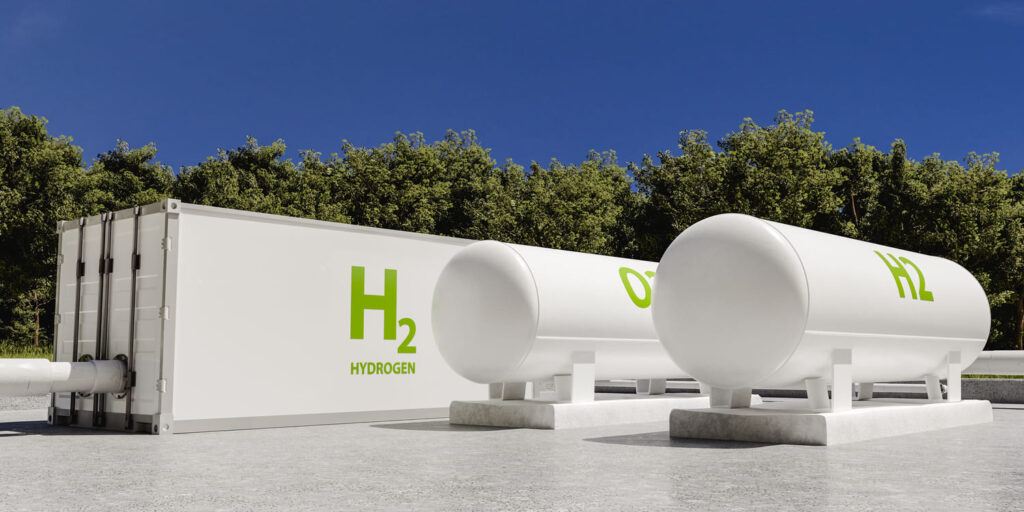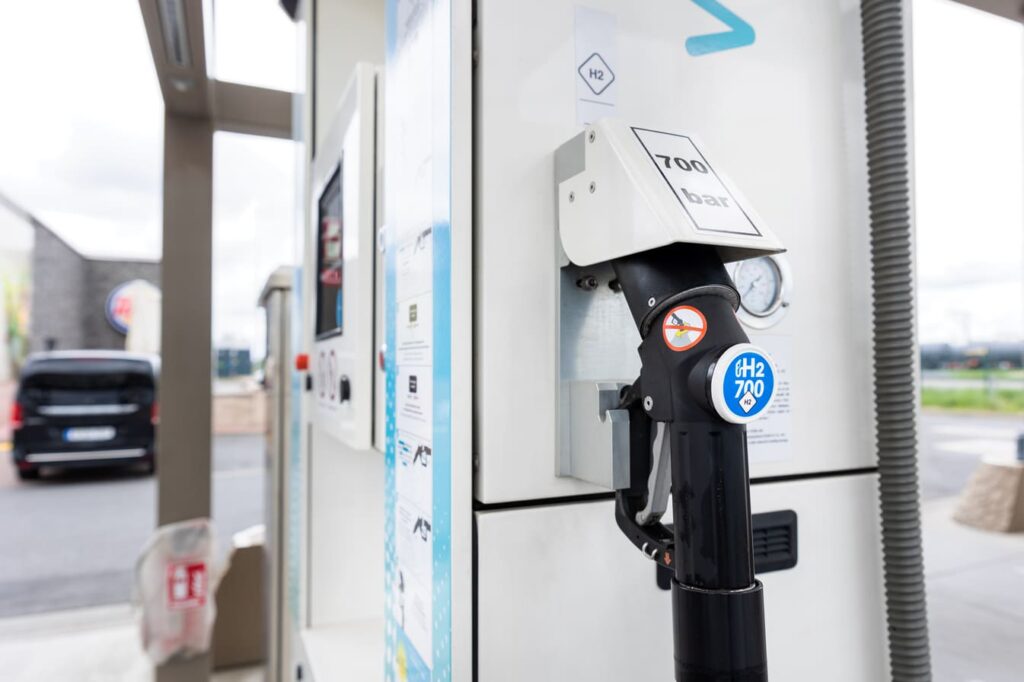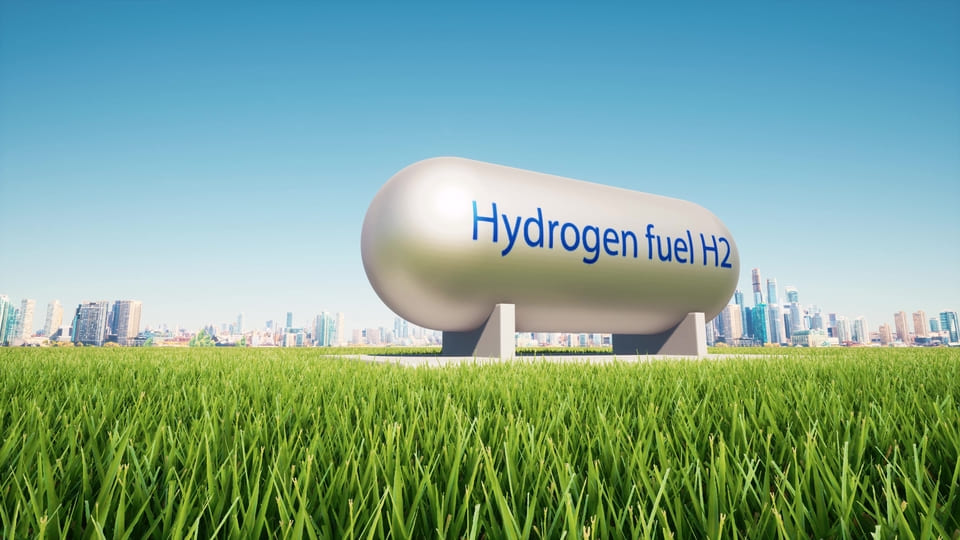Green Hydrogen: Sustainable Energy for a Clean Future
Green hydrogen has positioned itself as one of the pillars of the energy transition towards a cleaner and more sustainable system. This renewable fuel, produced from sources such as solar and wind energy through an electrolysis process, stands out for its ability to reduce greenhouse gas emissions in key sectors such as industry, transportation, and power generation.
With the global commitment towards a net-zero emissions future, renewable hydrogen is emerging as a key solution to decarbonize economies and ensure a flexible and efficient energy supply.
What is Green Hydrogen?
Green hydrogen, also known as renewable hydrogen, is an energy carrier produced through the electrolysis of water, using exclusively renewable energies such as solar or wind power. This process separates water molecules into hydrogen and oxygen without generating carbon emissions, distinguishing it from gray and blue hydrogen, which rely on fossil fuels and produce pollutant gases.

– Why is Renewable Hydrogen Key in the Energy Transition?
Renewable hydrogen is essential for the energy transition because:
It allows for the storage of renewable energy in large quantities and over long periods.
It can be used as a clean fuel in industries that are difficult to electrify, such as steel production or chemicals.
It is a versatile solution that enhances the flexibility and stability of the electrical system.
Comparison of Green Hydrogen with Other Types of Hydrogen
There are three main types of hydrogen depending on their production process: green, blue, and gray. Green hydrogen stands out as the only truly sustainable option, although each type has its own characteristics and applications.
– Green Hydrogen
Produced through the electrolysis of water using renewable energy sources such as solar or wind, green hydrogen does not generate CO₂ emissions, making it a clean solution ideal for decarbonizing the economy.
– Blue Hydrogen
Generated from fossil fuels with carbon capture and storage (CCS). Although it emits less CO₂ than gray hydrogen, it still relies on non-renewable sources, which limits its long-term sustainability.
– Gray Hydrogen
Produced from natural gas without carbon capture, gray hydrogen is the cheapest but also the most polluting, responsible for large CO₂ emissions during the methane reforming process.
How is Green Hydrogen Produced?

– The Electrolysis Process
Electrolysis is the most widespread method for producing green hydrogen. It involves:
Using an electrolyzer that applies an electric current to water.
Splitting water molecules into their basic components: hydrogen and oxygen.
Storing the hydrogen produced as gas or liquid for later use.
– Renewable Energy Sources Used: Solar, Wind, and Hydropower
To ensure the sustainability of green hydrogen production, only renewable energy sources are employed, such as:
Photovoltaic Solar Energy: Harnesses solar radiation to generate the electricity required for electrolysis.
Wind Energy: Wind turbines provide the clean electricity needed for the process.
Hydropower: Reservoirs and rivers are key sources for stable renewable electricity generation.
Advantages of Green Hydrogen in the Energy Transition
Green hydrogen is not only a clean and sustainable solution, but it also offers a range of strategic benefits that make it a key element in the energy transition towards decarbonized economies.
– CO₂ Emission Reduction
The main benefit of renewable hydrogen is that its production and use do not generate direct carbon dioxide emissions, making it ideal for decarbonizing sectors such as heavy industry, transportation, and power generation. Its large-scale implementation can significantly reduce the global carbon footprint.
– Energy Flexibility and Storage
Green hydrogen acts as a versatile energy carrier that allows:
Storing renewable energy for long periods, overcoming the limitations of batteries.
Balancing energy supply and demand on the electricity grid, ensuring system stability.
– Promotion of Sustainability and Green Job Creation
The production of renewable hydrogen fosters the development of renewable energies such as solar and wind, promotes sustainability, and generates employment in key sectors, from electrolyzer installation to the operation and maintenance of production plants.
Applications of Green Hydrogen
Green hydrogen has a wide range of applications that position it as an indispensable resource in the global energy transition. Some of these include:

– Heavy Industry
The steel, cement, and chemical industries rely on processes that require high temperatures and produce significant CO₂ emissions. Green hydrogen can replace fossil fuels as a heat source, enabling effective decarbonization in these sectors.
– Transportation
Renewable hydrogen is a clean solution for heavy transportation, including trucks, trains, ships, and even airplanes. Hydrogen fuel cell vehicles offer longer ranges and faster refueling times compared to traditional electric batteries.
– Power Generation and Energy Storage
H₂ can be stored and converted into electricity during periods of high demand or when renewable energy production is low, playing a critical role in ensuring grid stability. As production costs continue to decrease and global infrastructure expands, the hydrogen economy is expected to create millions of jobs and drastically reduce CO₂ emissions.
What Challenges and Obstacles Does the Implementation of Green Hydrogen Face?
Despite its numerous advantages, the implementation of green hydrogen faces challenges that must be overcome to achieve widespread adoption.
– High Production Costs
Currently, green hydrogen production is more expensive compared to gray or blue hydrogen due to the costs associated with electrolysis technology and renewable energy infrastructure. However, these costs are expected to decrease with technological advancements and economies of scale.
– Limited Infrastructure
The transportation, storage, and distribution of hydrogen require a robust and specialized infrastructure that is still underdeveloped in many regions, including Spain.
– Need for Expansion of Renewable Energy
To produce H₂ sustainably, it is essential to increase the capacity for generating renewable energy, such as solar and wind, which requires significant investment in new facilities.
– Competition with Other Energy Technologies
Green hydrogen competes with other clean energy storage and generation solutions, such as lithium-ion batteries and thermal storage systems, creating a need to balance the use of different technologies for specific applications.
Green Hydrogen in Spain: Present and Future
Spain is positioning itself as one of the leading countries in the production and adoption of green hydrogen, thanks to its abundant renewable energy potential and its commitment to energy decarbonization.
– Green Hydrogen Projects in Spain
Spain is home to numerous green hydrogen plant projects under development, aimed at producing renewable hydrogen on a large scale. These projects are designed to supply both the domestic market and export demand, with notable initiatives in regions such as Aragón, Andalusia, and the Basque Country.
– National Strategies and Goals
The Spanish Hydrogen Strategy sets ambitious targets, including the installation of 4 GW of electrolyzer capacity by 2030 and the promotion of sustainable mobility with hydrogen-powered vehicles. These goals position Spain as a key player in the European renewable energy landscape.
– Challenges for Spain in Green Hydrogen Development
Despite its significant potential, Spain faces challenges such as the lack of infrastructure for transportation and storage, and the need to increase the installed capacity of renewable energies to ensure competitive and sustainable hydrogen production.
Green Hydrogen Production: Technologies and Process
The production of green hydrogen is a key process in the transition toward the decarbonization of the economy. This type of hydrogen is produced using advanced technologies that utilize renewable energy sources such as solar or wind power, ensuring a completely carbon-free production cycle. Its large-scale implementation is essential to reducing reliance on fossil fuels and contributing to global sustainability goals.

– Electrolysis of Water
Green hydrogen is generated through a process known as water electrolysis. This method involves applying electricity to split water (H₂O) into its two main components: hydrogen (H₂) and oxygen (O₂).
What sets green hydrogen apart from other production methods is that the electricity used comes exclusively from renewable energy sources such as solar, wind, or hydroelectric power. This ensures that the entire process is carbon emission-free, avoiding the environmental impact associated with traditional methods like natural gas reforming or coal gasification.
Moreover, electrolysis is a versatile process that can be scaled to meet specific needs, ranging from decentralized production at industrial facilities to large-scale plants dedicated to energy storage and global distribution.
– Electrolysis Technologies
Several electrolysis technologies are being developed and utilized for renewable hydrogen production. Each offers specific characteristics in terms of efficiency, cost, and applications:
Alkaline Electrolysis
This is the most mature and widely used technology today.
It offers competitive costs due to its simplicity and the availability of materials.
It requires a constant electrical current, making it more suitable for applications where renewable energy is stable.
It is ideal for large-scale projects, such as green hydrogen plants in Spain, where renewable resources are abundant.
Proton Exchange Membrane (PEM) Electrolysis
Known for its higher efficiency and operational flexibility.
It can quickly adapt to the fluctuations of renewable energy sources like solar and wind power.
More compact, making it suitable for industrial applications and mobility solutions, such as hydrogen-powered trains and buses.
Its initial cost is higher due to advanced materials like platinum, but economies of scale are rapidly reducing these costs.
Solid Oxide Electrolysis (SOE)
Also referred to as Solid Oxide Electrolysis Cells (SOEC), this emerging technology promises the highest efficiencies by operating at high temperatures.
It uses renewable heat (e.g., concentrated solar power) to reduce the amount of electricity required.
Although it has higher initial costs and less commercial availability, it is a promising solution for the future of green hydrogen production, especially in industrial high-temperature settings.
Each of these technologies plays a crucial role in the expansion of green hydrogen, enabling its integration across various sectors and applications.
Renewable Resources Required
The sustainable production of green hydrogen directly depends on the availability of abundant renewable energy sources. To ensure continuous and competitive production, a robust infrastructure is required to efficiently capture and utilize resources such as:
Solar energy: Ideal for regions with high solar radiation, such as Spain, which boasts extensive photovoltaic plant fields.
Wind energy: Essential in areas with significant wind potential, enabling the generation of low-cost renewable electricity.
Hydropower: A stable source that can complement production during periods of lower solar or wind generation.
Countries with abundant renewable resources, such as Spain, Chile, and Australia, are leading the race to establish green hydrogen production plants. Their ability to combine advanced technologies with clean energy not only ensures hydrogen’s competitiveness in the global market but also positions these regions as key exporters in the H₂ economy.
In summary, the success of green hydrogen relies not only on electrolysis technologies but also on effectively integrating available renewable resources. This holistic approach is crucial to maximizing efficiency, reducing costs, and achieving a positive impact in the fight against climate change.
Proyectos de Hidrógeno Verde Internacionales y Casos de Éxito
The development of green hydrogen is revolutionizing the global energy transition. Various countries and companies are investing in innovative projects, hydrogen plants, and strategic alliances to establish this technology as a cornerstone of decarbonization.
Leading Countries in Green Hydrogen Production
Australia: Known for large-scale hydrogen projects like the Asian Renewable Energy Hub, which aims to produce hydrogen from wind and solar energy for export to Asia.
Germany: A pioneer in implementing policies such as the National Hydrogen Strategy, with initiatives like HySynGas focused on industrial applications.
Spain: A key player with projects like Puertollano, aimed at decarbonizing industrial sectors and promoting sustainable mobility.
Global Alliances to Foster Renewable Hydrogen
International cooperation is essential to accelerate the adoption of renewable hydrogen. Key alliances include:
European Clean Hydrogen Alliance: An EU initiative promoting green hydrogen production and use in hard-to-decarbonize sectors.
International Renewable Hydrogen Coalition: Brings together companies and governments committed to sustainable hydrogen production.
Bilateral Partnerships: Such as Germany and Morocco’s collaboration on hydrogen export projects.
These success stories and partnerships are laying the foundation for a global hydrogen economy.
Innovation and Future of Green Hydrogen
The advancement of green hydrogen directly depends on technological innovation and global policies driving its adoption. New technologies and economic prospects point to a promising future for this renewable energy source.

New Technologies and Advances in the Sector
More Efficient Electrolysis: Technologies such as proton exchange membrane (PEM) electrolysis are increasing efficiency and lowering production costs.
Solid-State Hydrogen: Advances in compact and safe hydrogen storage using innovative materials.
Decentralized Production: The use of small electrolyzer modules to produce green hydrogen in remote locations or directly at industrial sites.
Hydrogen in Synthetic Fuels: Projects like Haru Oni are converting green hydrogen into emission-free liquid fuels.
Is Green Hydrogen the Key to Net-Zero Emissions?
Green hydrogen is crucial for achieving global net-zero emission goals due to its versatility and ability to decarbonize sectors where other technologies fall short. Its key applications include:
Heavy and Maritime Transport: Providing clean fuel to reduce emissions in the logistics sector.
Chemical and Steel Industries: Replacing fossil fuels in carbon-intensive processes.
Energy Production: Acting as a flexible buffer to mitigate fluctuations in renewable energy production.
Thanks to these applications, green hydrogen is emerging as a cornerstone of global sustainability and decarbonization strategies.
Green Hydrogen Projects at RPow
At RPow, we take pride in being part of initiatives that are transforming the global energy landscape by positioning green hydrogen as a key solution for achieving sustainability and decarbonization. Our expertise in engineering and consulting allows us to lead projects that integrate advanced technologies and tailor-made solutions for each client.
One of our flagship projects is the evaluation of CSP + PV hybrid systems for standalone hydrogen production. We are actively involved in assessing the integration of photovoltaic (PV) and concentrated solar power (CSP) technologies with renewable hydrogen production, maximizing efficiency and minimizing emissions. For more information, visit the following link: : CSP + PV hybrid evaluation for standalone Hydrogen production – RPOW – Renewable power onwards
In addition, RPow has established a strong collaboration with ASE to drive innovative green hydrogen projects. This strategic alliance aims to accelerate the implementation of sustainable technologies and strengthen the energy transition in key markets. Together, the two companies have created a joint venture named Wulkan Energy.
To learn more, you can visit the following spanish articles: RPow se alía con el grupo polaco ASE para impulsar proyectos de hidrógeno verde desde Sevilla and La sevillana RPow y la polaca ASE se alían para convertir Sevilla en un polo de innovación del hidrógeno
Renewable
Power Onwards
Engineers with over 20 years of experience
